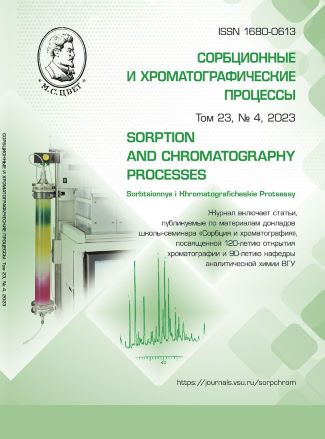Адсорбционная иммобилизация инулиназы из Aspergillus ficuum и Kluyveromyces marxianus: сравнительный аспект
Аннотация
Методами компьютерного моделирования выполнен виртуальный скрининг лигандов для иммобилизации грибной инулиназы из Aspergillus ficuum и дрожжевой инулиназы из Kluyveromyces marxianus. Разработан алгоритм для выявления молекулярного механизма адсорбционной иммобилизации инулиназ с использованием методов последовательного (каскадного) докинга. Визуализированы вероятные сайты связывания полимерных матриц с молекулами фермента из различных продуцентов при адсорбционной иммобилизации. Установлено, что образование комплекса инулиназы с заряженными матрицами носителей происходит в основном за счет водородных связей и ван-дер-ваальсовых взаимодействий. Показано, что при сорбции инулиназ из Aspergillus ficuum и Kluyveromyces marxianus на матрицах КУ-2, АВ-17-2П, ВИОН КН-1, ВИОН АН-1, КОПАН-90 и хитозана выявляются следующие сходства: 1) при взаимодействии обоих видов инулиназ с матрицей КУ-2 водородные связи образуются только между сульфогруппами носителя и молекулой белка; 2) между матрицей анионита АВ-17-2П и ферментами выявляется наличие лишь ван-дер-ваальсовых взаимодействий и отсутствие водородных связей; 3) хитозан образует с обеими инулиназами наибольшее количество водородных связей из исследуемых нами носителей.
Выявлены отличительные особенности инулиназ из Aspergillus ficuum и Kluyveromyces marxianus при сорбции на матрицах КУ-2, АВ-17-2П, ВИОН КН-1, ВИОН АН-1, КОПАН-90: 1) силы взаимодействия дрожжевой инулиназы с поверхностью смолы КУ-2 в целом выше, а число водородных связей и количество аминокислотных остатков, образующих ван-дер-ваальсовы взаимодействия, больше, чем у грибного фермента; 2) силы взаимодействия и число аминокислот, участвующих в ван-дер-ваальсовых взаимодействиях, для инулиназы из Kluyveromyces marxianus при сорбции на анионите АВ-17-2П также превышают их значения для энзима из Aspergillus ficuum; 3) в отличие от грибной инулиназы, у которой 21 аминокислотный остаток входит в состав сайтов связывания со всеми исследуемыми нами носителями, у дрожжевого фермента такой остаток только один.
Скачивания
Литература
Jafarizadeh-Malmiri H., Ghaz-Jahanian M.A., Berenjian A., Potential applications of chitosan nanoparticles as novel supports in en-zyme immobilization, Am. J. Biochem. Bio-technol., 2012; 8: 203-219. https://doi.org/10.3844/ajbbsp.2012.203.219
Ansari S.A., Husain Q., Potential appli-cations of enzymes immobilized on/in nano materials: a review, Biotechnol. Adv., 2012; 30; 512-523. https://doi.org/10.1016/j.biotechadv.2011.09.005
Vaghari H., Jafarizadeh-Malmiri H., Mohammadlou M., Berenjian A., Anarjan N., Jafari N., Nasiri S., Application of magnetic nanoparticles in smart enzyme immobilization, Biotechnology Letters, 2016; 38: 223-233. https://doi.org/10.1007/s10529-015-1977-z
Cipolatti E.P., Valério A., Henriques R.O., Moritz D.E., Ninow J.L., Freire D.M.G., Manoel E.A., Fernandez-Lafuente R., de Oliveira D., Nanomaterials for biocatalyst im-mobilization-state of the art and future trends, RSC Advances, 2016; 6: 104675-104692. https://doi.org/10.1039/C6RA22047A
Janecek S., Strategies for obtaining stable enzymes, Process Biochem., 1993; 28: 435-445.
Guzik U., Hupert-Kocurek K., Wojcieszynska D., Immobilization as a strate-gy for improving enzyme properties – Applica-tion to oxidoreductases, Molecules, 2014; 19: 8995-9018. https://doi.org/10.3390/molecules19078995
Lei Z., Bi S., Yang H., Chitosan-tethered the silica particle from a layer-by-layer approach for pectinase immobilization, Food Chem., 2007; 104: 577-584. https://doi.org/10.1016/j.foodchem.2006.12.008
Efremenko E.N., Tatarinova N.Yu., The effect of long-term preservation of bacterial cells immobilized in poly(vinyl alcohol) cryo-gel on their viability and biosynthesis of target metabolites, Microbiology, 2007; 76(3): 336-341. https://doi.org/10.1134/S0026261707030113
Liese A., Hilterhaus L., Evaluation of immobilized enzymes for industrial applica-tions, Chemical Society Reviews, 2013; 42: 6236-6249. doi: 10.1039/c3cs35511j
Efremenko E.N., Stepanov N.A., Ni-kolskaya A.B., Senko O.V., Spiricheva O.V., Varfolomeev S.D., Biocatalysts based on im-mobilized cells of microorganisms in the pro-duction of bioethanol and biobutanol, Catalysis in Industry, 2011; 3(1): 41-46. https://doi.org/10.1134/S207005041101003X
Efremenko E.N., Stepanov N.A., Gudkov D.A., Sen'ko O.V., Lozinskij V.I., Varfolomeev S.D., Immobilizovannye gribnye biokatalizatory dlya polucheniya kompleksa cellyulaz, gidrolizuyushchego vozobnovlyae-moe rastitel'noe syr'e, Kataliz v promyshlen-nosti, 2013; 1: 68-77.
Barbosa O., Ortiz C., Berenguer-Murcia Á., Torres R., Rodrigues R.C, Fernandez-Lafuente R., Strategies for the one-step immo-bilization-purification of enzymes as industrial biocatalysts, Biotechnol. Adv., 2015; 33: 435-456. https://doi.org/10.1016/j.biotechadv.2015.03.006
Garcia-Galan C., Berenguer-Murcia Á., Fernandez-Lafuente R., Rodrigues R.C., Poten-tial of different enzyme immobilization strate-gies to improve enzyme performance, Adv. Synth.Catal., 2011; 353: 2885-2904. https://doi.org/10.1002/adsc.201100534
Mateo C., Palomo J.M., Fernandez-Lorente G., Guisan J.M., Fernandez-Lafuente R., Improvement of enzyme activity, stability and selectivity via immobilization techniques, Enzyme Microb. Technol., 2007; 40: 1451-1463. https://doi.org/10.1016/j.enzmictec.2007.01.018
Fernandez-Lafuente R., Stabilization of multimeric enzymes: strategies to prevent sub-unit dissociation, Enzyme Microb. Technol., 2009; 45: 405-418. https://doi.org/10.1016/j.enzmictec.2009.08.009
Balcao V.M., Vila M.M., Structural and functional stabilization of protein entities: State-of-the-art, Advanced Drug Delivery Re-views, 2015; 93: 25-41. https://doi.org/10.1016/j.addr.2014.10.005
Bolivar J.M., Mateo C., Rocha-Martin J., Cava F., Berenguer J., Fernandez-Lafuente R., Guisan J.M., The adsorption of multimeric enzymes on very lowly activated supports in-volves more enzyme subunits: stabilization of a glutamate dehydrogenase from Thermus ther-mophilus by immobilization on heterofunction-al supports, Enzyme Microb. Technol., 2009; 44: 139-144. https://doi.org/10.1016/j.enzmictec.2008.10.004
Min K., Yoo Y.J., Recent progress in nanobiocatalysis for enzyme immobilization and its application, Biotechnology and Biopro-cess Engineering, 2014; 19: 553-567. https://doi.org/10.1007/s12257-014-0173-7
Efremenko E.N., Lozinsky V.I., Ser-geeva V.S., Plieva F.M., Makhlis T.A., Kazankov G.M., Gladilin A.K., Varfolomeyev S.D., Addition of polybrene improves stability of organophosphate hydrolase immobilized in poly(vinyl alcohol) cryogel carrier, Journal of Biochemical and Biophysical Methods, 2002; 51(2): 195-201. https://doi.org/10.1016/s0165-022x(01)00135-x
Rodrigues R.C., Ortiz C., Berenguer-Murcia Á., Torres R., Fernández-Lafuente R., Modifying enzyme activity and selectivity by immobilization, Chem. Soc. Rev., 2013; 45: 6290-6307. https://doi.org/10.1039/c2cs35231a
Karpov S.I., Matveeva M.V., Selemenev V.F., Kinetics of the sorption of amino acids by KU-2-8 gel cationite, Russian Journal of Physical Chemistry A, 2001; 75(2): 266-271.
Shkutina I.V., Stoyanova O.F., Selemenev V.F., Grigor'eva G.A., Adsorption im-mobilization of glucoamylase on amphoteric polyelectrolytes, Russian Journal of Physical Chemistry A, 2001; 75(11); 1843-1845.
Krisilova E.V., Eliseeva T.V., Sele-menev V.F., Krisilov A.V., Oros G.Y., The influence of side substituents in α-amino acids on their sorption by a cation-exchange mem-brane, Russian Journal of Physical Chemistry A, 2009; 83(10): 1763-1767. https://doi.org/10.1134/S0036024409100240
Ohta K., Akimoto H., Matsuda S., To-shimitsu D., Nakamura T., Molecular cloning and sequence analysis of two endoinulinase genes from Aspergillus niger, Biosci. Biotech-nol. Biochem., 1998; 62(9): 1731-1738. https://doi.org/10.1271/bbb.62.1731
Basso A., Spizzo P., Ferrario V., Knapic L., Savko N., Braiuca P., Ebert C., Ricca E., Calabrò V., Gardossi L., Endo- and exo-inulinases: enzyme-substrate interaction and rational immobilization, Biotechnol. Prog., 2010; 26(2); 397-405. https://doi.org/10.1002/btpr.334
Artyukhov V.G., Kovaleva T.A., Khol-yavka M.G., Bityutskaya L.A., Grechkina M.V., Obraztsova T.B. Study of the oligomeric structure and some physicochemical properties of inulinase from Kluyveromyces marxianus Y-303, Biophysics, 2009; 54(6): 675-680. https://doi.org/10.1134/S0006350909060025
Artyukhov V.G., Holyavka M.G., Ko-valeva T.A., Structural and functional proper-ties of inulinases. Ways to regulate their activi-ty, Biophysics, 2013; 58(4): 493-501. https://doi.org/10.1134/S0006350913040039
Uhm T.B., Chung M.S., Lee S.H., Gour-ronc F., Housen I., Kim J.H., Van Beeumen J., Haye B., Vandenhaute J. Purification and char-acterization of Aspergillus ficuum en-doinulinase, Biosci Biotechnol Biochem., 1999; 63(1): 146-151. https://doi.org/10.1271/bbb.63.146
Ettalibi M., Baratti J.C. Purification, properties and comparison of invertase, exoin-ulinases and endoinulinases of Aspergillus ficuum, Appl Microbiol Biotechnol., 1987; 26: 13-20. https://doi.org/10.1007/BF00282143
Artyuhov V.G., Holyavka M.G., Ko-valeva T.A. Fiziko-himicheskie i kineticheskie svojstva inulinaz, Vestnik biotekhnologii i fizi-ko-himicheskoj biologii im. Yu.A. Ovchinnikova, 2013; 2: 67-77.
Holyavka M.G., Artyukhov V.G., Kon-dratyev M.S., Samchenko A.A., Kabanov A.V., Komarov V.M., In silico design of high-affinity ligands for the immobilization of in-ulinase, Computers in Biology and Medicine, 2016; 71: 198-204. https://doi.org/10.1016/j.compbiomed.2016.02.015
Holyavka M.G., Kovaleva T.A., Grech-kina M.V., Ostankova I.V., Artyukhov V.G., Inulinases from various producers: the features of their permolecular organization, Applied Bi-ochemistry and Microbiology, 2014; 50(1): 10-16. https://doi.org/10.1134/S0003683814010050
Holyavka M., Artyukhov V., Kovaleva T., Structural and functional properties of in-ulinases: A review, Biocatalysis and Biotrans-formation, 2016; 34(1): 1-17. https://doi.org/10.1080/10242422.2016.1196486
Holyavka, M.G., Evstigneev, M.P., Artyukhov, V.G., Savin, V.V., Development of heterogeneous preparation with inulinase for-tubular reactor systems, Journal of Molecular Catalysis B: Enzymatic, 2016; 129: 1-5. https://doi.org/10.1016/j.molcatb.2016.03.006
Holyavka M.G., Kondratyev M.S., Terentyev V.V., Samchenko A.A., Kabanov A.V., Komarov V.M., Artyukhov V.G., The Molecu-lar Mechanism of Adsorption Immobilization of Inulinase on Polymer Matrices, Biophysics, 2017; 62 (1): 5-11. https://doi.org/10.1134/S0006350917010109
Abdullatypov A.V., Kondratyev M.S., Kholyavka M.G., Artyukhov V.G., Recon-struction of the spatial structure of inulinase from Kluyveromyces marxianus to find regula-tory pathways of its catalytic activity, Biophys-ics, 2016; 61(4): 565-571. https://doi.org/10.1134/S0006350916040023
Artyukhov V.G., Kovaleva T.A., Khol-yavka M.G., Bityutskaya L.A., Grechkina M.V., Thermal inactivation of free and immo-bilized inulinase, Applied biochemistry and microbiology, 2010; 46(4): 385-389. https://doi.org/10.1134/S0003683810040034
Holyavka M.G., Kayumov A.R., Baydamshina D.R., Koroleva V.A., Trizna E.Yu., Trushin M.V., Artyukhov V.G., Effcient fructose production from plant extracts by im-mobilized inulinases from Kluyveromyces marxianus and Helianthus tuberosus, Interna-tional Journal of Biological Macromolecules, 2018; 115: 829-834. https://doi.org/10.1016/j.ijbiomac.2018.04.107
Holyavka M.G., Kondratyev M.S., Lukin A.N., Agapov B.L., Artyukhov V.G., Immobilization of inulinase on KU-2 ion-exchange resin matrix, International Journal of Biological Macromolecules, 2019; 138: 681-692. https://doi.org/10.1016/j.ijbiomac.2019.07.132
Koroleva V.A., Sakibaev F.A., Shelo-menceva T.N., Holyavka M.G., Artyuhov V.G. Izuchenie zakonomernostej termicheskoj inaktivacii svobodnogo i immobilizovannogo na matrice hitozana tripsina, Vestnik VGU. Seriya «Himiya. Biologiya. Farmaciya», 2018; 3: 58-63.
Sakibaev F.A., Holyavka M.G., Makin S.M., Artyuhov V.G. An in silico search for the sites of potential binding with charged and hydrophobic carriers in the molecules of en-doinulinase from Aspergillus ficuum and ex-oinulinase from Aspergillus awamori, Biophys-ics, 2019; 64(3): 323-330. https://doi.org/10.1134/S0006350919030199
Sakibaev F.A., Makin S.M., Holyavka M.G., Artyuhov V.G. Zakonomernosti formi-rovaniya dimernyh kompleksov molekulami ekzo- i endoinulinaz. Izmenenie sostava poten-cial'nyh sajtov svyazyvaniya s zaryazhennymi i gidrofobnymi nositelyami dlya ih immobi-lizacii, Sorbtsionnye i khromatograficheskie protsessy, 2021; 21 (6): 905-927.








